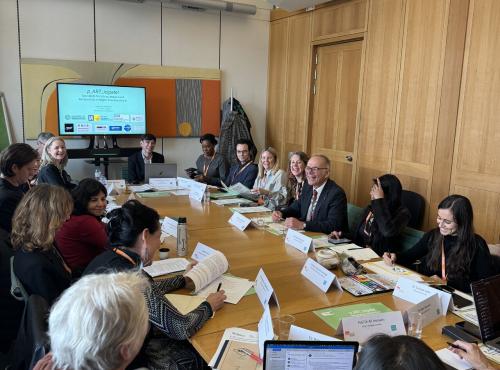The Leng Review and the Physician Associate Role: A System Under Strain
July was a busy and politically charged month for healthcare. The government launched its 10-year plan for the NHS, junior doctors staged another five-day strike, nurses voted to reject their latest pay offer, and a welfare policy U-turn raised questions about the Government’s ability to deliver major reforms - alongside concerns about how bold pledges would be funded.
Amidst these announcements and unrest, the Leng Review - an independent report into the roles of Physician Associates (PAs) and Anaesthesia Associates (AAs), led by Professor Gillian Leng - was released on 16th July. A timely and important review, its findings speak to some of the NHS’s most urgent and deep-rooted challenges.
So how did we get to this point? What did the Leng Review find—and what does it reveal about the NHS more broadly?
The Origins of the Physician Associate Role
The Physician Associate (PA) role was initially established in the United States. In the 1960s, Duke University Medical Center assembled the first cohort of “physician assistants,” drawing on experience from the fast-track medical training used during World War II. The inaugural class consisted of four former US Navy Hospital Corpsmen, with a curriculum designed to quickly equip them with the clinical skills needed to support doctors in practice.
The role was introduced to the UK in 2003, when two US-trained PAs joined GP practices in Tipton, West Midlands, marking the beginning of its adoption in the NHS. Between 2004 to 2006, pilot UK training programs had launched in Hertfordshire, Wolverhampton and St George’s and around 2005 the UK Association of Physician Assistants (UKAPA) had been established as the professional body. The role formed part of a broader shift towards building multidisciplinary teams (MDTs) in the NHS—expanding access to care while enabling doctors to focus on more complex patients.
In 2013, UKAPA voted to adopt the title physician associate and since then, the role has gradually expanded and become more formalised within the NHS workforce.
Physician associates are mid-level dependent medical professionals trained in the medical model to perform a wide range of generalist clinical tasks. These include taking patient histories, conducting examinations and procedures, diagnosing illnesses, and formulating treatment plans.
Crucially, PAs must always work under the supervision of a named senior doctor and are not legally permitted to prescribe medication or request ionising radiation. The training pathway typically requires either a bioscience undergraduate degree or a previous healthcare qualification, followed by an intensive two-year postgraduate degree and a national practical and written exam.
Designed to be flexible and generalist, the PA role was intended to adapt across a range of clinical settings. In general practice, they have often been deployed to manage lower-acuity patients, freeing up GPs to focus on more complex care.
Initially, the role attracted broad support and was seen as a potential solution to growing NHS workforce shortages. In General Practice Forward View (2016), then Health Secretary Jeremy Hunt set a goal of training and placing 1,000 PAs in primary care by 2020—despite fewer than 20 being employed in the sector at the time. That ambition has since grown. The 2023 NHS Long Term Workforce Plan set targets 10,000 PAs in the NHS by 2036/37, positioning them as a key part of future workforce expansion.
Concerns and Controversy
While the physician associate role had expanded gradually since its introduction, serious concerns began to grow in 2023 following two high-profile inquests.
In March, the inquest into the death of Emily Chesterton, a 30-year-old woman from Salford, found that she had been misdiagnosed by a PA at her GP surgery, whom she believed to be a GP. Her symptoms - caused by a blood clot - were instead attributed to a sprain, long Covid, and anxiety. The coroner concluded that she likely would have survived had she been referred to hospital.
By July, a second inquest was released into the death of Susan Pollitt, a patient at Royal Oldham Hospital. It found that errors made by a PA in managing her care, including the prolonged use of an abdominal drain and the recommendation to clamp the drain, led to her death. It also emerged that, in the previous year, a nurse only approved the associate's competence in using the equipment because she assumed he was a doctor.
These cases led to increasing scrutiny. In November 2023, the BMA called for an immediate pause on PA recruitment, raising concerns about patient safety and role confusion. A BMA-commissioned survey found that a quarter of the survey sample incorrectly believed PAs were doctors, and many assumed they held seniority over junior doctors. The union also highlighted pay disparities, noting that PA starting salaries were often higher than those of foundation-year doctors.
Public debate gained momentum online, with criticism that PAs were being used to substitute doctors at lower cost. In response, the Union for Medical Associate Professions (UMAP) published findings in March 2024 showing the impact on PA wellbeing: 92% of respondents said the national discourse had negatively affected their mental health, and 81% said they had considered leaving the profession.
In December 2024, the General Medical Council (GMC) became the official regulator for PAs and AAs. The move was opposed by the BMA, which argued that shared regulation between PAs and doctors could exacerbate public confusion. That same month, the Royal College of Physicians issued interim guidance emphasising the limits of the PA role, including a clear ban on prescribing and making admission or discharge decisions.
By September 2024, the Royal College of General Practitioners had withdrawn its previous support for PAs in primary care. And in November, Health Secretary Wes Streeting announced an independent review led by Professor Gillian Leng, to assess the safety, effectiveness and future of both the PA and AA roles.
What Did the Leng Review Find?
The Leng Review drew on both primary and secondary research, collecting evidence from published studies, stakeholder submissions, and the views of patients, physician associates (PAs), anaesthesia associates (AAs), doctors, and other healthcare professionals.
Overall, it found that there was no compelling evidence to conclude that PAs were either categorically safe or unsafe. The available research on outcomes was limited, with most studies being small in scale or methodologically inconclusive. As such, the review emphasised the need for better data and more robust research before definitive conclusions could be drawn.
Patient feedback was generally positive. Many reported feeling listened to and having a good experience after seeing a PA. However, concerns were raised about role clarity, especially when patients were unaware they were not seeing a doctor. Other issues included barriers to care—such as delays caused by PAs not being able to prescribe—and a lack of confidence about whether they were seeing the appropriate professional for their condition.
Doctors who contributed to the review raised concerns about the additional supervisory burden that PAs and AAs can place on clinical teams. Many felt underprepared to supervise effectively and pointed to a lack of structured training for doing so.
While doctors noted that safety issues were sometimes identified and corrected through supervision, there were differing views between PAs and doctors about what tasks were appropriate for PAs to undertake.
Beyond the immediate question of the PA and AA roles, the review also highlighted broader systemic challenges within the NHS workforce. These included a lack of effective management, unclear boundaries between professional groups, and poor integration of staff. The NHS, it noted, employs more types of clinical staff than any other healthcare system globally, but often lacks clarity about how those roles interact.
Finally, the review raised several concerns about medical education and training, including the shortage of training posts following the expansion of medical school places, increasing competition from international graduates, poorly structured training rotations, and the fragmentation of medical teams - which has left many junior doctors without adequate mentorship or support.
In terms of recommendations, the review proposed renaming the roles “physician assistant” and “physician assistant in anaesthesia” to more accurately reflect their supportive position within medical teams and reduce patient confusion. It also recommended that PAs wear clearly distinguishable uniforms and identification, and work within defined team structures under the oversight of a named senior clinician as their formal line manager.
To improve safety and ensure consistency, the review called for national standards for supervision, training, and credentialling, developed in collaboration with medical royal colleges. These standards should enable PAs to take on expanded responsibilities—such as prescribing or ordering certain tests—where they have been appropriately trained and assessed. Over time, there should be scope for career development into more senior ‘advanced’ physician assistant roles.
The review also advised clearer limits on where and how PAs should practice. It recommended that newly qualified PAs spend at least two years in secondary care before working in primary care or mental health, and that they should not see patients with undifferentiated conditions unless triaged first. In anaesthesia, it called for continued monitoring of safety outcomes.
Broader recommendations focused on the need for better medical leadership and team design. Doctors, the review argued, should be supported in their supervisory roles through training and dedicated time for line management. It also urged the Department of Health and Social Care to convene a working group to set out clear multidisciplinary team models, and called for safety reporting systems to routinely collect data by staff group to help identify system-wide issues.
What Can We Learn from the Leng Review?
While the Leng Review was primarily focused on the roles of physician associates and anaesthesia associates, its recommendations and the tensions that prompted it tell a much broader story about the NHS—about how change is managed, how staff are valued, and how pressure within the system creates friction between professionals.
The review itself set out three key lessons from previous workforce developments that should shape future reforms: the need for a clear vision that is well communicated, the importance of strong leadership and engagement, and the critical role of effective local change management.
While these recommendations were broadly welcomed, the review also exposed deeper systemic issues.
For one, a large part of the debate played out prominently on social media. Tensions around the role escalated into targeted abuse, with some prominent figures receiving personal attacks. Both PAs and Doctors reported feeling unable to speak publicly for fear of harassment.
Valid concerns around training, clarity, and supervision became mixed with hostility, undermining constructive discussion on both sides of the debate.
That dynamic also speaks to how easily valuable contributions can be dismissed. While questions around PA training and oversight are valid, there were moments where legitimate concerns shaded into broader dismissal of their professional worth.
Some critics focused narrowly on the two-year master’s degree, overlooking the prior training many PA students bring – having most commonly completed a bioscience undergraduate degree. Moreover, a significant portion of PA students have come from other healthcare backgrounds like nursing, midwifery, or allied health professionals. They already have technical and clinical skills, and the path in some cases provided an important professional development route.
Within healthcare, there has been a broader trend where nurses, allied health professionals, and other staff frequently report feeling undervalued or invisible. Again, while there were valid safety and regulation concerns, there should be caution not to disregard the professional and technical expertise required to take up these roles, their importance as part of the broader NHS team, and the value that courses like this play in offering opportunities for career development and upskilling.
Equally, the review - and the tragic cases that prompted it - highlighted how these problems rarely stem from one role or policy alone. Many of the most serious concerns arose in environments defined by crowding, understaffing, and poor supervision.
In the case of Susan Pollitt, her family were clear that the PA was not solely to blame. Kate Pollitt, Susan's daughter, noted that staffing levels in the hospital were very low and on the night her mother died "it took nearly four hours to find a doctor in the whole of the hospital". Susan had been treated in a corridor, moved between wards due to bed shortages, and left without adequate medical oversight.
The Pollitts clearly made the point that the PA alone wasn't to blame, saying he was the "only one who showed Susan - and us - any empathy". These conditions shaped the outcome as much as the staff involved.
Emily Chesterton’s case, while different, also touches on systemic issues that go beyond role definition—such as delays in care, inconsistent triage, and wider problems with how women's pain is understood and responded to. While it is important to understand the impact the confusion around the physician associate role played in these cases, it must not end at this and must also consider broader issues within the system it operates.
One of the recurring themes across the review is management. The absence of strong, well-supported leadership was noted both in the events leading up to the review and in the wider findings. As Kathryn Minshew noted in the review’s foreword: “In contrast to the country’s affection for doctors and nurses, healthcare managers are often given less credit. In reality, healthcare is one of the most complex businesses to run.”
Strong management is essential to the functioning of the NHS, and yet the training, support, and resources available to managers often fall short.
Policies targeted at improving NHS management featured heavily in the latest 10-year health plan, but more must be done to analyse the training, support and resources available to management and the ways clinical teams can be best run.
Finally, the review cast a spotlight on the fragile state of medical education and training. It is striking that a report about PA and AA roles would devote so much space to the difficulties facing junior doctors—but those issues are deeply connected.
Complaints about PA pay, for example, often stem from comparisons with junior doctor salaries. It also raised the importance of broader issues in medical degrees such as unpredictable rotations, fragmented mentorship, and limited training capacity - challenges that create competition and tension between professional groups.
Ultimately, the review is a reminder that rapid workforce expansion, if not well planned or supported, may lead to unintended consequences. The rollout of PA roles, and more recently the medical degree apprenticeships, show the risks of growing numbers without proper integration. In both cases, students have been caught in the middle of controversy and policy churn, often left uncertain about the future of their role.
Conclusion: A System Under Strain
The Leng Review has highlighted more than just the roles of PAs and AAs - it has exposed a health service wrestling with change amidst constant pressure. In the drive to expand and adapt the workforce, we must not lose sight of the valuable contributions made at every level of the NHS, or the training, experience, and dedication it takes to reach those roles.
However, change cannot be introduced without clarity, structure, and support. Patient safety, team cohesion, and public trust all depend on how well that balance is struck.
Ultimately, the review serves as a warning. Workforce reform is not just about numbers—it’s about relationships, trust, and accountability. Without careful planning and investment, well-intentioned policies risk creating new problems in the name of solving old ones.
Future workforce policy must ensure that new roles are clearly defined, properly supported, and integrated into the system in a way that builds - rather than erodes - public trust and clinical safety.



